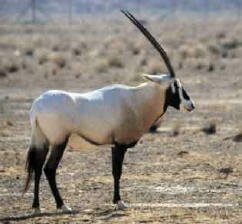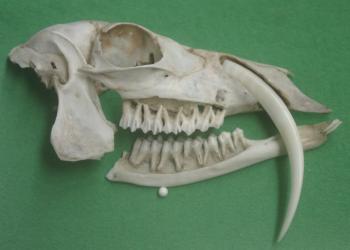 When I was in Australia, Sailor Boy and I were intrigued by the fact that they seemed to have a type of kangaroo to fill every biological niche. They had kangaroos like deer, like rabbits, like mice — even like lemurs. This came back to me as I was researching unicorns for Rampant and trying to reconcile the astoundingly different legends in my mind. Unicorns were described as being monstrous, gigantic animals that could attack elephants in one legend, and as being analogous to goats in another.
When I was in Australia, Sailor Boy and I were intrigued by the fact that they seemed to have a type of kangaroo to fill every biological niche. They had kangaroos like deer, like rabbits, like mice — even like lemurs. This came back to me as I was researching unicorns for Rampant and trying to reconcile the astoundingly different legends in my mind. Unicorns were described as being monstrous, gigantic animals that could attack elephants in one legend, and as being analogous to goats in another.
What if, like kangaroos, they were actually just different kinds of the same animal, filling different ecological niches?
From that brainstorm, I devised my magical world’s five species of unicorns, each of which correspond, loosely, to a different legend/mythology. This decision really opened up my world, because the different behavior and characteristics of different unicorn species provided much fodder for plot and world development.
And that was just the tip of the iceberg. Though, from a biological standpoint, my creatures don’t fit neatly into any taxonomic structure, I took as a jumping off point the family of bovids (though my killer unicorns aren’t actually ruminates — i.e., multiple-stomached grazing animals).
 This was actually the source of an interesting Twitter conversation the other day with Tiffany Trent, fantasy writer and scientist, who said she always thought of unicorns as being closest to deer (cervids). But the reason I’ve generally avoided that classification in my world is because the defining characteristic of my unicorns are, of course, their horns, which are, like many venom reservoirs (think snake fang resevoirs), hollow. Bovids (sheep, goats, antelope, gazelles, bison, yaks, etc.) have hollow horns. Deer have bony antlers that they shed once a year. For the other deerlike characteristics of certain of my unicorns (since, as I said before, they do not all conform to the European forest-dwelling heraldic/Beaglesque vision), there are analogous antelope species. The oryx for many years was mistaken for a unicorn by folks who only saw it from the side.
This was actually the source of an interesting Twitter conversation the other day with Tiffany Trent, fantasy writer and scientist, who said she always thought of unicorns as being closest to deer (cervids). But the reason I’ve generally avoided that classification in my world is because the defining characteristic of my unicorns are, of course, their horns, which are, like many venom reservoirs (think snake fang resevoirs), hollow. Bovids (sheep, goats, antelope, gazelles, bison, yaks, etc.) have hollow horns. Deer have bony antlers that they shed once a year. For the other deerlike characteristics of certain of my unicorns (since, as I said before, they do not all conform to the European forest-dwelling heraldic/Beaglesque vision), there are analogous antelope species. The oryx for many years was mistaken for a unicorn by folks who only saw it from the side.
However, I did love this picture of a fanged deer skull. Slap a horn on that and it looks a lot like one of my unicorns:

This is part of the fun of fantasy — you can decide that your utterly made up creatures fit any taxonomic classification that you like. Obviously, despite outward appearance and certain social structure analogies, my unciorns are not bovids. They don’t have those stomachs. They aren’t grazers. They’re sharks, jaguars, hawks… and, um platypus.

Scary, huh? When I was in Australia, I saw two platypus: one in the wild, and one in captivity. I watched them feed the captive one a few (live) prawns. You want to see a vicious eater: watch a platypus at dinner. there were prawn bits flying EVERYWHERE.
Where was I? Right, Imaginary monsters.
So I borrowed liberally from different mammals — predator, bovid, etc., to create my monsters, and added a big dose of magic.
I’m a firm believer that in a fantasy world, you have to work to make everything else that much more believable, if you expect people to swallow “unicorns.” Since my fantasy is set in this world — a world with cell phones, animal rights activists, long range sniper rifles, endangered species laws, and animal testing, I had to work all that into the story. I also had to deal with the reality of fake unicorns.
 The most common fake unicorn was the narwhal, whose spiral,, toothy “tusk” was for years harvested and sold throughout Europe as true unicorn horn. Most of the royal houses of Europe possessed one of these, and they were sometimes worth more than their weight in gold.
The most common fake unicorn was the narwhal, whose spiral,, toothy “tusk” was for years harvested and sold throughout Europe as true unicorn horn. Most of the royal houses of Europe possessed one of these, and they were sometimes worth more than their weight in gold.
Unicorn horn, you see, was said to possess magical healing/purifying properties. To eat and drink with utensils/cups made with unicorn horn, or possessing a rim of unicorn horn, was supposed to prevent poisonings. There was lost of fake horn (narwhal and otherwise) being passed off as belonging to a unicorn. In my book, I treat this legend as one of false metonymy, though unicorn horns themselves do have magical properties, at least where hunters are concerned.
 And, in more recent times, folks have used animal husbandry to actually make unicorns. Did anyone else see the unicorn that used to tour with the RIngling Bros. Barnum & Bailey Circus? That unicorn was one of a herd created by a pagan church leader in the 70s and 80s out of a type of Angora goat. He even patented the procedure!
And, in more recent times, folks have used animal husbandry to actually make unicorns. Did anyone else see the unicorn that used to tour with the RIngling Bros. Barnum & Bailey Circus? That unicorn was one of a herd created by a pagan church leader in the 70s and 80s out of a type of Angora goat. He even patented the procedure!
I love this picture of the created, goat-like unicorn. Though the behavior of the zhi in my novel is a result of an ancient Chinese legend about a zhi, this is a surprisingly accurate depiction.
And, finally, there are unicorns that are a result of genetic mutation, such as the Italian deer pictures at the top of this post. I was thrilled when that news story started popping up last year. The fact that it was a wild unicorn found in Italy made it feel like it was a present, just for me.
I’m excited for people to read the book, since most go into it with an assumption that the unicorns I’m talking about are horses with horns — and come out with a very different impression. I know that there are some readers who are just going to say (actually HAVE said to me — heck, we even got some rejection letters that said it) “I don’t like my unicorns like that” or, worse, “unicorns aren’t like that,” which I find really funny because throughout the history of humanity, unicorns have been very much like the creatures I describe.
A friend of mine recently described RAMPANT as a “unicorn book for people who don’t like unicorn books,” on account of that fact that I veer away from the fluffy, sparkly, innocent Trapper Keeper unicorns populating most books for children. But at the same time, I don’t know. I love Beagle, and I love my book. I think it’s possible to hold both of these images in your head at once.
Maybe not if you’re Astrid, and have to actually kill the things, but for the rest of us… sure.






5 Responses to Visualizing Monsters, pt. 2